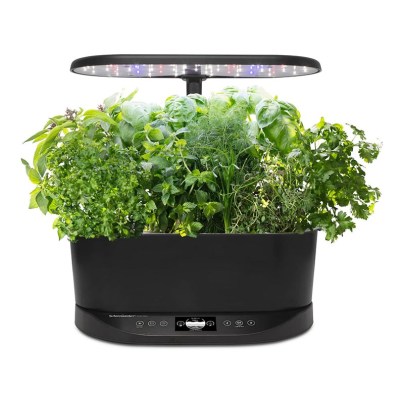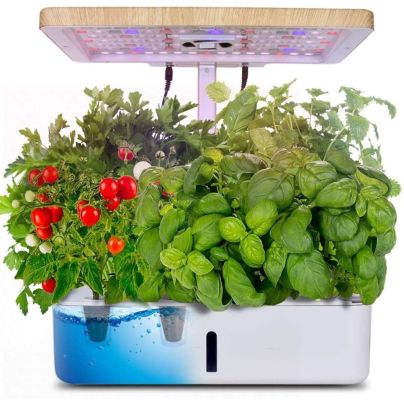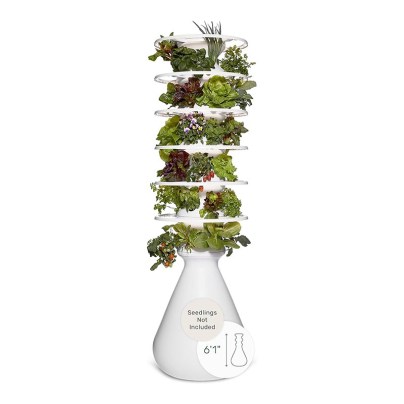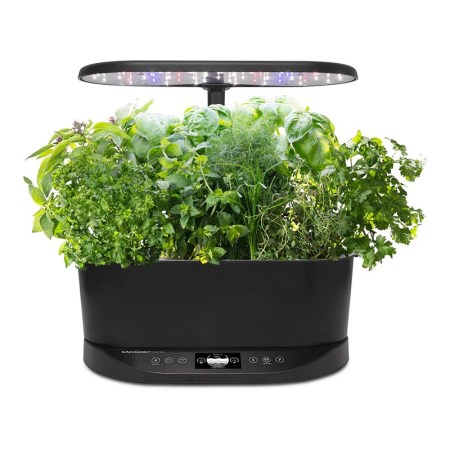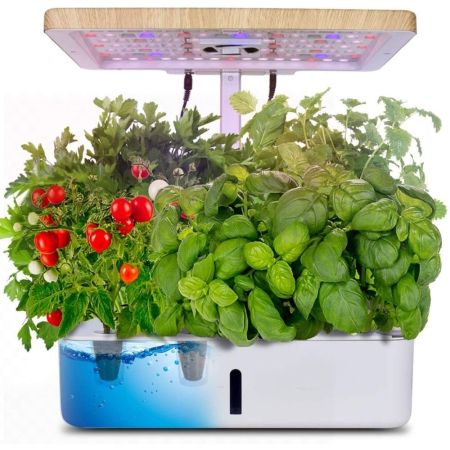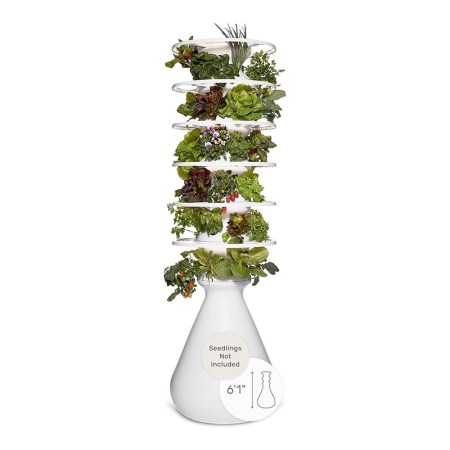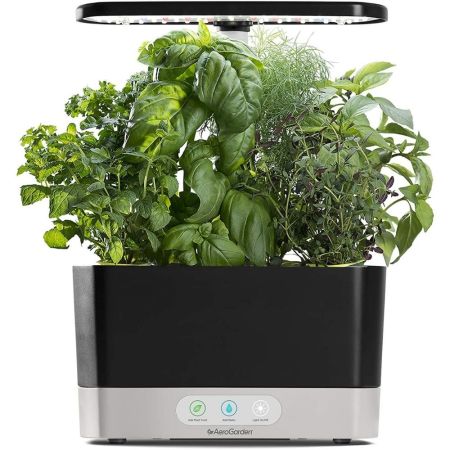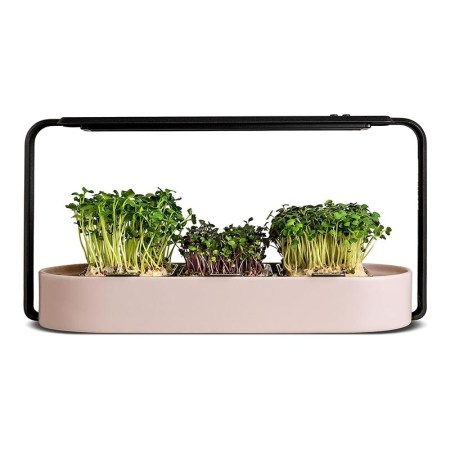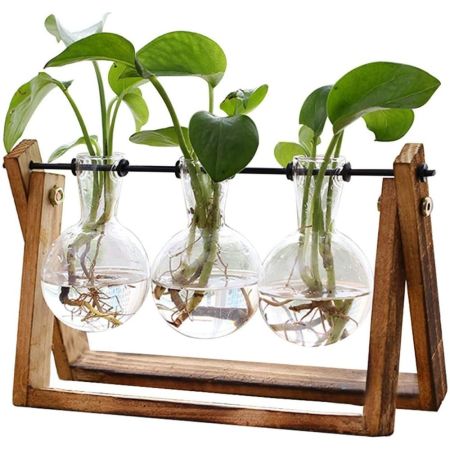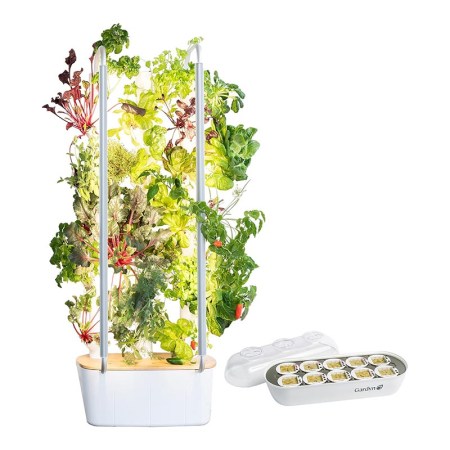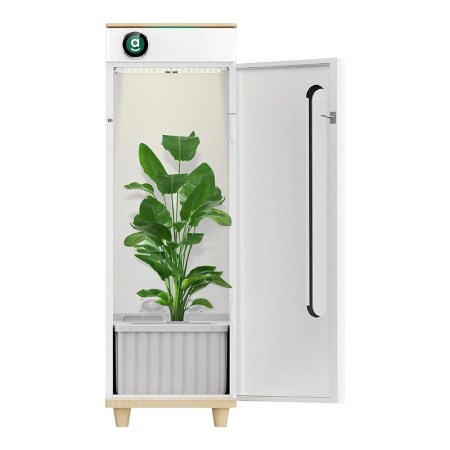We may earn revenue from the products available on this page and participate in affiliate programs. Learn More ›
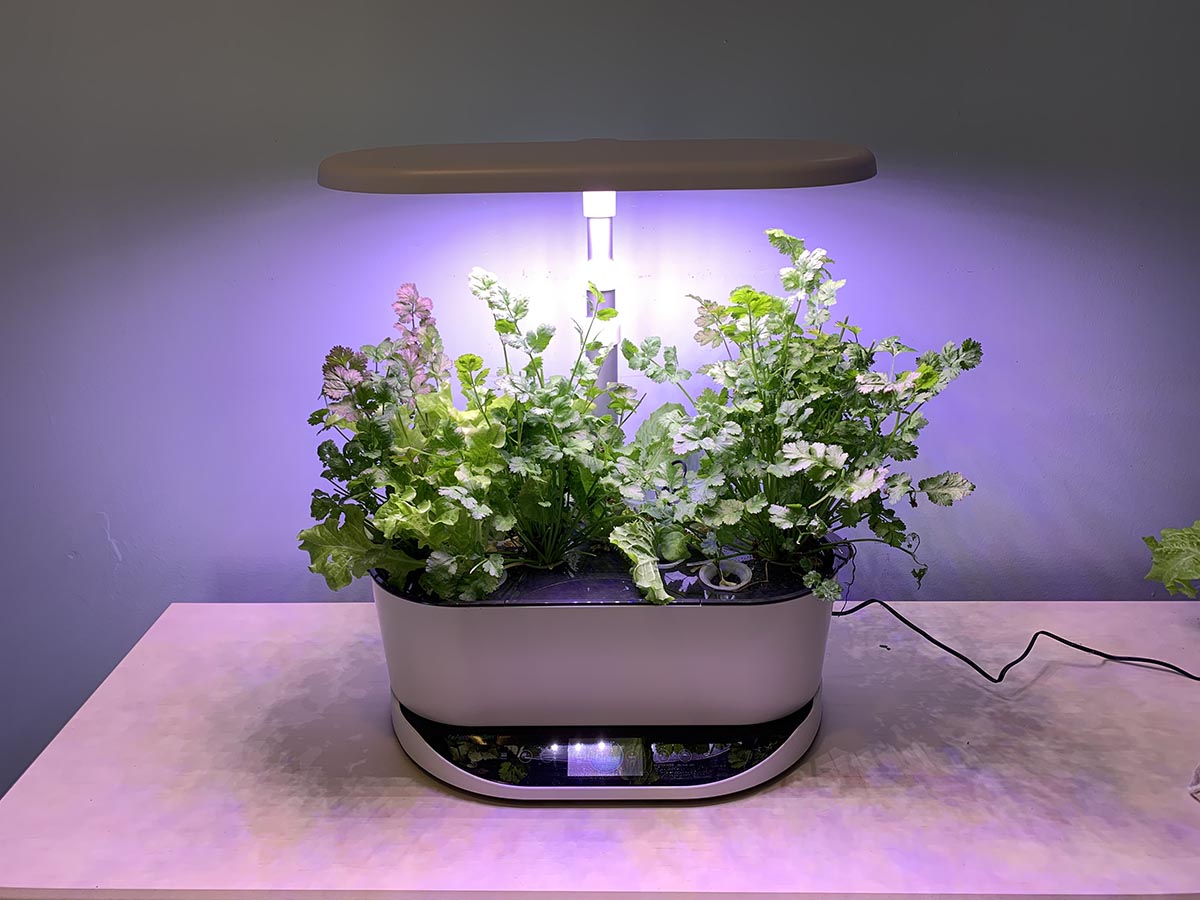
Hydroponics—the practice of growing plants in water rather than soil—is popular because it offers a way to produce a bounty of plants in a relatively small area in an indoor garden. These systems also tend to be user-friendly, so even newbie growers are likely to succeed. Best of all, hydroponic systems often are all-inclusive: They provide the container for growing the plants, and most come with lights, plant foods, and seeds, so you don’t have to be an expert to start growing.
Because of the wide range of consumer hydroponic systems available, choosing the best option can be challenging. To guide shoppers to the ideal product, we recently tested eight different indoor hydroponic systems to evaluate the top options on the market today.
When testing the best hydroponic systems, we looked for ease of use, the number of plants the system would accommodate, and any extra features included. Check out our top picks for indoor gardening with these hydroponic systems.
- BEST OVERALL: AeroGarden Bounty Hydroponic System
- BEST BANG FOR THE BUCK: Moistenland Indoor Garden Starter Kit
- BEST LARGE-CAPACITY: Lettuce Grow Farmstand Hydroponic System
- BEST FOR BEGINNERS: AeroGarden Harvest Hydroponic System
- BEST FOR MICROGREENS: Ingarden Organic Microgreens Starter Kit
- BEST FOR ROOTING: XXXFlower Plant Terrarium With Wooden Stand
- BEST DESIGN: Gardyn Home Kit 2.0 Hydroponic System
- BEST FOR SINGLE PLANTS: Hey Abby Grow Box OG Hydroponic System
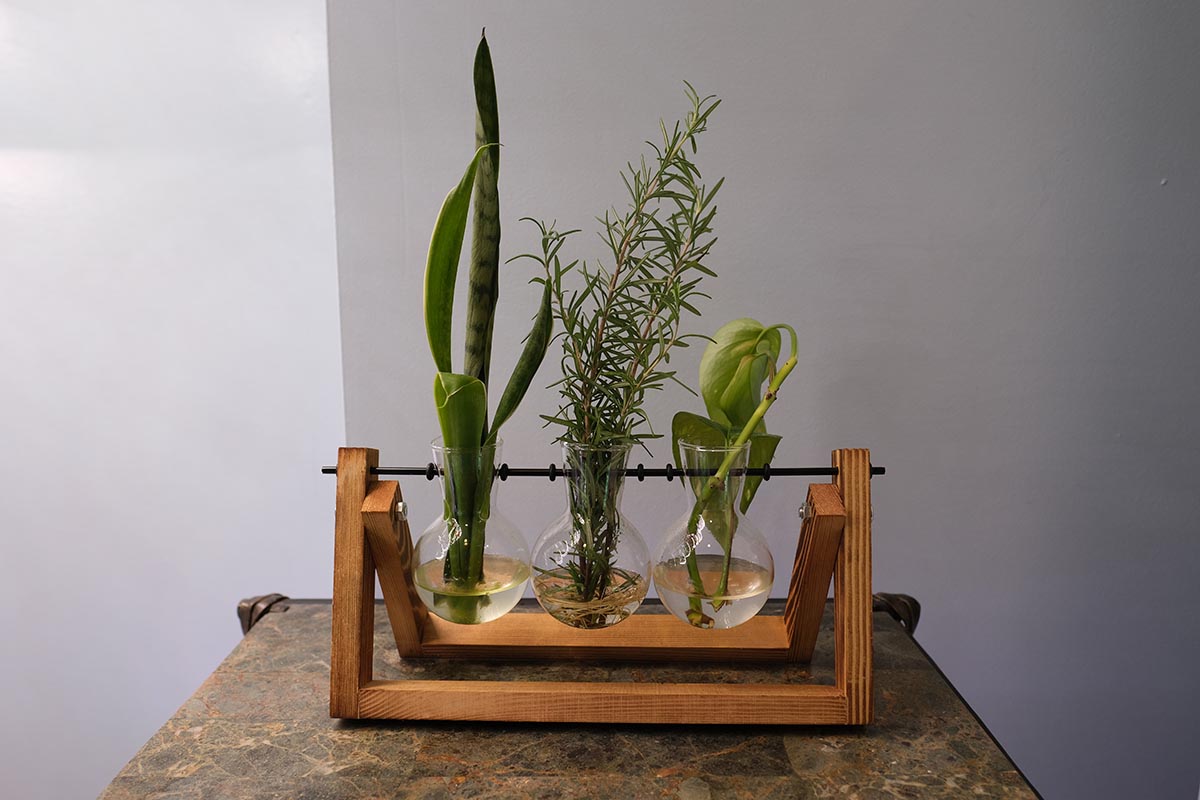
How We Tested the Best Hydroponic Systems
When evaluating these hydroponic systems, we considered over a dozen companies and looked at the brand, customer reviews, features of the product, extra items included, and how well the system grew plants. We also looked at durability and ease of use when testing and evaluating these products.
Each product was scored using a rubric that specifically evaluated the watering system, how well the plants in the system thrived, how easy the system was to set up and use, any extra features the product included, types of plants the system could grow, the durability of the product, and how attractive the setup was. We also considered the value of the product for the price.
As we tested each hydroponic system, we looked closely at how well the plants grew and how easy the system was to use and maintain. To do this, we tested each system for a minimum of 6 weeks, and some of the systems were tested for over a year.
Our Top Picks
To qualify as a top pick, a hydroponic system needed to have a water circulation system that keeps the water fresh. For those that are all-inclusive systems, we looked for bright grow lights that can be adjusted in height as the plants grow taller. The following hydroponic systems vary in design and size, but each is well suited to growing healthy herbs and plants indoors.
Best Overall
AeroGarden Bounty Hydroponic System
See ItProduct Specs
- Size: 34 inches high by 17.25 inches wide by 11.25 inches deep
- Capacity: 9 plants
- Additional features: Touch screen, vacation mode, trellis, seeds included
Pros
- All-inclusive system comes with seeds, humidity caps for seed germination, and liquid plant food.
- Generous grow height (up to 24 inches) is ideal for large plants such as peppers and tomatoes
- Easy-to-use touch screen makes scheduling light and water circulation simple and convenient
Cons
- Width of 17.25 inches is a bit too tight for all plants to comfortably grow
The AeroGarden Bounty grows up to nine plants and comes with a seed kit of the user’s choice. Thanks to a convenient touch screen, growers can set their own light and watering schedule, and there’s a vacation mode for when the system will be unattended.
One of the system’s best features is its tall grow height of 24 inches—the highest of any smaller hydroponic system in our lineup. The grow height makes it easier to nurture larger plant varieties, such as peppers and tomatoes, without worrying about plants getting their leaves singed on the lights. The system also includes a trellis, which is helpful when growing such larger plants.
The Bounty has a large water reservoir, so the system only needs minimal topping off. It also comes with liquid plant food and humidity caps for seeds to germinate. However, in testing—growing a combination of lettuces and herbs—the width of the system proved a bit short. This led to stunted growth of some plants, while others competed for light. For example, when we placed cilantro and a short lettuce variety next to each other, the cilantro grew taller and blocked light from the lettuce, which failed to truly thrive.
While AeroGarden could fix this problem by making the Bounty wider, we found the solution to be simply using fewer grow stations. When replanting seeds in the system during a second round of testing, we planted fewer plants (six instead of nine) and found that they did better, growing larger and looking more healthy.
Despite the width of the system being a bit short for our preferences, after we figured out how to work around this issue, the AeroGarden Bounty earned our best overall spot for the number of plants it grows, its reasonable price, its tall grow height, and for being an inclusive kit that makes hydroponics simple.
Get the AeroGarden Bounty hydroponic system at Amazon or AeroGarden.
Best Bang for the Buck
Moistenland Indoor Garden Starter Kit
See ItProduct Specs
- Size: 19.5 inches high by 10.25 inches deep by 13.8 inches wide
- Capacity: 12 plants
- Additional features: Air circulation fan, water-level window, tweezers for seeds, watering cup
Pros
- Has a light mode for growing both vegetables and flowers
- Handles on the bottom of the tray allow for easy transportation
- Comes with covers, seed plugs, and plant pods for user-friendliness
- Has a convenient plug at the bottom of the water reservoir for easy emptying
Cons
- Not an all-inclusive kit; does not come with plant food or seeds
- The holes on the seed plugs are very small, and it’s hard to get seeds in
- Plants can grow to only 11.2 inches in height, so it’s not suitable for large plant varieties
The Moistenland hydroponics growing system features 12 growing stations, yet it costs less than many six-station systems. The system includes a water reservoir, an overhead LED grow light, and a fan to circulate air through plant foliage. It comes with a 12-station grow deck and a see-through water-level window, so with a glance, users can see how much water is in the reservoir.
Buyers receive 12 growing pods, 14 coconut coir seed plugs, and 12 clear covers to create optimal humidity for seeds until they sprout. Seeds and plant food, however, are not included. The grow lights are on an 18-hours-on/6-hours-off timer, and the watering system circulates every 30 minutes.
In testing, we found the holes on the included seed pods to be very small, making it challenging to get the seeds in. Fortunately, Moistenland does provide a pair of plastic tweezers specifically for transferring seeds into the plugs, which helped somewhat.
The system includes an adjustable light hood that allows room for most but not all lettuces and herbs to grow comfortably to up to 11.2 inches. Some of our plants pressed up against the lights and were damaged when they got too tall, but this shouldn’t be an issue with regular harvesting.
While the plant holes in the system looked to be a bit close to each other, this didn’t cause a problem during testing. However, we found it’s best to start all plants at the same time, as larger plants can block the light from smaller plants when they’re started at different times.
Get the Moistenland hydroponic system at Moistenland or Amazon.
Best Large-Capacity
Lettuce Grow Farmstand Hydroponic System
See ItProduct Specs
- Size: 72 inches high, 22 inches in diameter
- Capacity: 36 plants
- Additional features: pH kit, pH stabilizer, plant food, timers for pump and lights
Pros
- Easy assembly thanks to a single plastic pipe running down the center of the system
- Large (20 gallon) water reservoir means minimal tank filling
- Comes with plant food, a pH kit, and timers, as well as optional app access
Cons
- Doesn’t come with seeds; ready-to-plant seedlings must be purchased separately and are expensive
- Cord holder on the front of the water reservoir didn’t work well in testing
- 2 separate cords are needed for lights and water pump, which detracts from the system’s visual appeal
The Lettuce Grow Farmstand that we tested has the capacity for 36 full-size plants, making it the largest hydroponic system on our list. The Farmstand comes with a teardrop-shaped base that can hold 20 gallons of water, which means we didn’t have to top off the water reservoir as often as with some of the smaller systems.
The system is adjustable—gardeners can add or remove sections as desired to increase or decrease the number of plants. This Farmstand can hold as few as 18 and as many as 36 plants. We loved that the Farmstand is constructed with high-quality, durable materials yet is also made with recycled ocean-bound plastic; it even comes in 100 percent recyclable packaging.
Despite its impressive size, the Farmstand proved to have a simple assembly process in testing—it uses a single durable plastic pipe that runs through the center of the system.
However, one downside we found is that it can be difficult to secure all the attachments and lights together. While they rotate and lock into place, this proved a bit tricky on some sections.
The Farmstand comes with two timers, one for lights and one for the water pump, which can be set and then left alone, making it simple to set up. However, the system is not controlled through an app, so remote monitoring or setting of lights and watering is not possible. App access can provide alerts about when to add plant food and harvest produce, and the fact that the system does not need Wi-Fi to work may be a benefit to some gardeners.
This system is not restricted to indoor use; growers can choose whether or not to purchase lights (which are not necessary when the system is used outdoors). Plant food, a pH kit, and a pH-down solution (to test and adjust the system’s pH) are included, but Lettuce Grow systems do not come with seeds or plants. Gardeners do have the option to purchase seedlings (sprouted plants ready to put into the system) from the company. While the seedlings were expensive, they were in perfect condition when they arrived, and we did not have a single plant die throughout the testing process, even though we had to delay transplanting some of the plants by 3 weeks.
We did have another pesky issue with the system. On our test model, the cord holder on the front of the water reservoir didn’t work very well, and the cords kept popping out. Also, the dual cords and timers made this system a little less attractive than some others.
Get the Lettuce Grow hydroponic system at Lettuce Grow.
Best for Beginners
AeroGarden Harvest Hydroponic System
See ItProduct Specs
- Size: 17.4 inches high by 10.5 inches wide by 6 inches deep
- Capacity: 6 plants
- Additional features: Water and food refill indicator, humidity caps
Pros
- Suitable for small spaces; compact footprint can fit on ledges, desks, and beneath cabinets
- Seeds and plant food included to grow 6 popular herb varieties
- Simple to set up, which is a plus for beginners as well as experienced gardeners who don’t want to fuss
Cons
- Plants can grow to only 12 inches tall—herbs must be harvested before reaching the top or they can be damaged
- Lights are on 15 hours and then shut off; no option for users to set their own light schedule
Even newbies can stretch their green thumb with this system from leading hydroponic systems manufacturer AeroGarden. The Harvest indoor herb garden provides everything necessary to care for its six growing stations. We loved the simple setup: Gardeners simply insert plant pods, add water and plant food, plug it in, and it’s ready to grow. Humidity caps to help germinate seeds when starting the system are included.
The system comes with six plastic pots and six seed plugs that are already preseeded (with Italian basil, Thai basil, parsley, dill, thyme, and mint) and ready to go. Liquid plant nutrients are also included. For convenience, the Harvest automates both lighting and water circulation. The system turns the LED grow lights on for 15 hours per day, though users can turn the lights on and off manually as well. Water circulation is automatic, and the unit features both a low-water and a time-to-add-nutrient indicator to take the guesswork out of indoor hydroponics.
One downside to this system is that it lacks an adjustable light timer: the lights simply come on for 15 hours a day, then turn off until the cycle starts again. The height of the light hood is limited, too. It only offers about 12 inches for plants to grow, which may prove too short for the herbs. Our dill and our basil, for instance, were damaged because they grew too tall and pressed against the hot light before we could harvest them.
Get the AeroGarden Harvest hydroponic system at Amazon, Walmart, or AeroGarden.
Best for Microgreens
Ingarden Organic Microgreens Starter Kit
See ItProduct Specs
- Size: 7.88 inches high by 15.9 inches wide by 5.9 inches deep
- Capacity: 3 seed pads
- Additional features: Extra wicks and power adapters
Pros
- 3 preseeded pads and extra wicks come with the kit
- The slim design fits easily on a countertop or window ledge
- All pieces except the grow light are dishwasher-safe for cleaning convenience
- High-quality ceramic and metal materials with no plastic parts
Cons
- Using the system can be expensive; not a huge harvest yield and replacement seed pads are pricey
- Despite the small size, the system weighs more than 7 pounds
This hydroponic kit from Ingarden is specifically designed for sprouts, also called microgreens. The kit consists of a ceramic water reservoir, over which a metal ledge and individual seed trays rest with a wicking system to provide seeds with consistent moisture.
Grow lights, seed pads, and extra wicks are included, but replacement seed pads are not. Since sprouts grow and are ready to be harvested within about a week, this means gardeners must purchase additional seed pads or a sprout medium and seeds on their own to keep growing.
We tested this product with both the seed pads that the Ingarden came with as well as aftermarket hemp growing medium and alfalfa seeds. Although the seed pads were significantly more convenient, the results were very similar, so this kit allows growers the option to continue growing on their own without having a subscription to Ingarden for additional seed pads, which can be more cost-effective over time.
We loved that this kit is entirely dishwasher-safe (except for the grow lights), which simplifies cleaning and maintenance. The ceramic water reservoir is also a nice change from the traditional plastic reservoirs hydroponic systems typically use and can be a benefit for users seeking to avoid growing plants in plastic.
We also appreciate the simple light timer on this kit: We just pressed a button to set the timer to go off in 12 hours. The grow lights can also be dimmed, and resetting the timer is a breeze with just a few presses of the button.
Another positive aspect to this kit is its small size. We tested it on a kitchen counter where it took up very little space, so we believe just about anyone could find a place for it in the home. Plus, the kit even comes with different power adapters for use in different countries.
One downside to this kit is that the replacement seed pads can be expensive compared with buying sprouts at the store. In addition, we found that the yield wasn’t huge—we used all the sprouts to prepare just one dinner for two—but they can easily be regrown in about a week.
Get the Ingarden hydroponic system at Amazon or Ingarden.
Best for Rooting
XXXFlower Plant Terrarium With Wooden Stand
See ItProduct Specs
- Size: 5.5 inches high by 4 inches deep by 11 inches wide
- Capacity: 3 glass vases
- Additional features: None
Pros
- Unique design; serves as an attractive display as well as a hydroponic system
- Suitable for small spaces; can be placed on a ledge, stylish ladder, table, or desk
- Virtually no setup required; simply fill vases with water and insert cuttings
Cons
- The necks of the glass vases are narrow, making it difficult to fit thicker cuttings
Few gardening processes are more straightforward than taking cuttings from existing houseplants or vines and starting them in water. The XXXFlower hydroponics garden includes three see-through glass bulbs to fill with water to encourage root development. It also serves as an attractive decoration for a sunny windowsill or countertop with its wood and black metal framing.
While the system doesn’t include LED lights or a water-recirculating pump, it works via a tried-and-true plant-propagation method that is simple but effective. When roots develop, plants can be transplanted into pots or to an outdoor garden spot.
During testing, we found this system was very easy to set up. We also appreciated its small size and good looks; it could pretty up just about any spot that gets enough natural light for plants. However, we found the necks of the glass vases to be quite narrow—while we could easily fit herbs (such as the rosemary we rooted), we had trouble getting snake plants and succulents into the water. That issue aside, this system gets high marks for its affordability, attractiveness, simple setup, and effectiveness at helping plants grow roots.
Get the XXXFlower hydroponic system at Amazon.
Best Design
Gardyn Home Kit 2.0 Hydroponic System
See ItProduct Specs
- Size: 64 inches high by 12 inches deep by 24 inches wide
- Capacity: 30 plants
- Additional features: Cameras, trial membership, plant nursery
Pros
- Capable of growing up to 30 full-size plants in a small footprint
- Seeds, pods, and plant food are all included in the system
- Easy light and watering schedule setup through the Gardyn app
Cons
- Plants can grow large enough to block light from new, smaller plants
The
hydroponic system boasts a unique design in that it can grow 30 full-size plants in just 2 square feet of space. It comes with everything gardeners need to get started, including preseeded and ready-to-go seed pods, plant food, grow lights, and app access to set a light and watering schedule.
This Gardyn system also comes with built-in cameras so growers can check the progress of their plants or monitor them while they’re on vacation. One of the things we loved when testing this system is how compact it is; its narrow profile and reasonable height of just over 5 feet allow it to fit just about anywhere in a home. The lights and water pump are all controlled through one cord, which can easily be hidden behind the water reservoir for a neat appearance.
We also found it was easy to set the light and watering schedule via the Gardyn app, which let us control light and water from anywhere. Plus, growers can obtain a Gardyn membership that makes ordering additional plants through the app a snap. (Note: Wi-Fi is required.)
One issue we noticed in testing is that when plants grow large, they can block the light from smaller plants. However, with regular harvesting and planting seedlings at synchronized intervals, this didn’t prove to be a major concern for us.
Get the Gardyn hydroponic system at Amazon or Gardyn.
Best for Single Plants
Hey Abby Grow Box OG Hydroponic System
See ItProduct Specs
- Size: 48 inches high by 15.75 inches deep by 15.75 inches wide
- Capacity: 1 plant
- Additional features: Trellis, plant food, harvesting clippers
Pros
- System comes almost fully assembled for easy, convenient setup
- Plant food, trellis, and clippers included for simplified plant maintenance
- Door cover included to keep the bright light from intruding in the room; also maintains privacy for the plant
Cons
- Lack of complete installation instructions leaves users to figure out setup
- Our test model was a bit noisy, but the company assured us that new versions don’t have this issue
The Hey Abby Grow Box is a single-plant enclosed hydroponic system that offers an ample grow height of 31.5 inches for a large plant. Although the system doesn’t include seeds, it does come with plant food, a trellis, and harvesting clippers, as well as a seed substrate pod for growers to get started with their own plants. A fan for humidity control, built-in grow lights, and an automatically locking door are included as well.
The system comes with app access, which is required for the lights and water pump to work, so Wi-Fi is required. In testing, we planted a poblano pepper seed, placed it in the Hey Abby, and set it to “Seed Mode” on the app. Our pepper grew beautifully and quickly, and we appreciated that the app provided reminders about when to top off the water tank and add plant food (about once a week).
One feature we enjoyed about this system was the optional door cover, which blocks the light from the grow box and keeps what’s being grown inside private. We also found the automatic door locks to be a plus; the easy open-and-close feature, operated by turning the dial on the front, made accessing our pepper plant simple.
One drawback to this system is its somewhat disruptive sound. Although Hey Abby’s volume is listed at 35 decibels (quieter than the 40 decibels we found when we tested with a decibel-measuring app), it sounded even louder in an enclosed space. We tested it in a small bedroom and had to switch it off completely during video calls and conferences. Unlike other hydroponic systems on this list, the Hey Abby runs constantly when operating, so the volume is constant when the system is on.
We’ve been testing this system for about 6 months, and our poblano pepper plant continues to produce peppers.
Read our full review: Hey Abby Grow Box OG Hydroponic SystemGet the Hey Abby hydroponic system at Amazon or Hey Abby.
Jump to Our Top Picks
What to Consider When Choosing a Hydroponic System
Plants need four essential elements to thrive: water, oxygen, light, and nutrients. A successful hydroponic system must supply an adequate amount of all four. For those new to indoor gardening, the options may seem confusing, but today’s manufacturers create types of hydroponic systems that automate much of the process.
Type
While all hydroponic systems supply plant roots with water and nutrients, the method varies. There are six common types of hydroponic systems, all with unique strong points, but some are better suited to commercial settings than DIY home settings.
- Wicking: Also known as “passive hydroponics,” wicking uses an absorbent material, such as a natural fiber rope, to draw water from a reservoir to the plant’s roots. Wicking can be as simple as putting a plant in a soilless growing medium, such as perlite, and running a short piece of rope from the growing medium to water. These types of hydroponic systems are well suited for small plants, such as sprouts and microgreens.
- Deep water culture: Often found in all-inclusive consumer hydroponic systems, deep water culture (DWC) involves growing plants in small containers. These are sometimes called pods, although different brands may have different names for them. Typically made of plastic, where the plants’ roots spread through the water in a reservoir, a DWC system features a small pump for circulating nutrients and adding oxygen to the water.
- Ebb and flow: Also called a “flood-and-drain” system, the ebb-and-flow method involves a small pump that circulates water, flooding plant roots with nutrient-rich water and then draining. By exposing the roots to water and nutrients every few hours, the plants receive all the nutrients they need. In some ebb-and-flow systems, the plant roots will sit in water collected in small reservoirs around the pods. However, in others, the plant roots don’t sit in water between waterings. Ebb-and-flow systems are ideal for water conservation, as the system recirculates the water in the reservoir, eliminating the need for fresh water for every watering.
- Nutrient film technique: Similar to a DWC system, a nutrient-film technique (NFT) system circulates nutrient-rich water through the roots of the plants. Rather than the mesh pots being placed in a water reservoir, the pots are side by side in long channels. An NFT system can contain many or only a few connected channels. While this system is used extensively for commercial growing, a few smaller NFT systems are available to consumers for in-home use.
- Aeroponic: Rather than suspending plant roots in water, in an aeroponic system, the roots sit above the water level, and a mister sprays the roots with nutrient-rich water. Aeroponic systems aren’t quite as popular as DWC for home systems, but a few models are available.
- Drip: Usually limited to commercial growers, drip hydroponics feature tubing with small drip nozzles located above every plant. Water circulates through the tubing and drips on each plant, and the excess water runs through a mesh pot containing soilless medium and drains back to the pump. The dripping cycle repeats every few minutes.
Experience Level
To operate a hydroponic growing system, the operator needs basic knowledge about how hydroponics work. This means, for most systems, that growers should be experienced in sprouting plants from seeds, knowing when plants need plant food, monitoring the water flow of the reservoir, and adjusting nutrient levels and pH.
Fortunately, with today’s consumer hydroponic systems, indoor gardening is simple and straightforward. Systems like the popular AeroGarden come with mesh pods and soilless medium (often coconut coir plugs), as well as a pump for circulating water and keeping roots moist and healthy. Unlike classic terrariums, most of today’s in-home systems also feature grow lights on timers that provide the correct amount of light for optimal growth.
Available Space
One of the convenient characteristics of at-home hydroponic systems is that users can grow more plants on a smaller footprint because the roots don’t need to spread out to seek nutrients. A typical home hydroponics system can be as large as a few feet deep and wide or as small as a few inches deep and wide, depending on the type of setup and the number of plants. The most common models, such as the AeroGarden Harvest, can fit on a kitchen countertop or a table and take up no more than 1 to 2 square feet of space—yet the Gardyn can grow up to 30 full-size plants.
Plant Types
Indoor hydroponic systems can grow a wide variety of plant types. While smaller systems such as the AeroGarden are best used for herbs and smaller varieties of peppers and tomatoes, larger systems like the Lettuce Grow Farmstand and Gardyn can grow virtually anything, including large lettuces such as romaine, full-size tomato or pepper plants, kale, Swiss chard, bok choy, and even cabbage. Flowers can be grown in hydroponic systems too.
Temperature
Consistent temperature is essential to plant growth, so commercial hydroponic growers often have water heaters to regulate the water temperature. However, in-home hydroponic systems don’t require the same temperature-control level because they’re usually placed in a home where the temperature remains between 60 and 80 degrees Fahrenheit. Many experts suggest that the optimal water temperature for plant growth is between 68 and 71.6 degrees Fahrenheit.
Substrates and Nutrients
A soilless growing medium is normally used in hydroponics. These mediums can include coconut coir plugs or mineral wool. However, some systems, such as the Lettuce Grow Farmstand, have plants that are started in actual soil and then transplanted into small pods to grow without additional soil in the hydroponic system.
Some systems come with plants or seeds already in the substrate. For example, the AeroGarden Harvest and Bounty, as well as the Gardyn, include preseeded and ready-to-grow pods. As the plants grow, the roots extend below the pod into the reservoir or channel beneath.
Nutrients used in hydroponic systems can be in either powder or liquid form. Gardyn and Lettuce Grow come with powders that must be dissolved in warm water before being added to the water reservoir, while the AeroGarden systems come with liquid plant food that can be poured directly into the reservoir.
Maintenance
Automated hydroponic systems require minimal maintenance relative to a traditional garden. Most systems recommend topping off the tank reservoir about once a week and adding plant food at the same time. It’s also recommended that the reservoir be cleaned every month or so to prevent the buildup of algae in the tank.
During the growing cycle, users may also need to wipe down the unit’s surface with a clean, damp rag to maintain its appearance: They aren’t immune to dust!
The Advantages of Owning a Hydroponic System
There are many advantages to owning a hydroponic garden system, including water conservation, reduced risk of pest problems, and fresh produce year-round.
According to Dr. Michael B. Timmons, professor emeritus and graduate professor in the Department of Biological and Environmental Engineering at Cornell University, “Producing food as efficiently as possible and minimizing the use of our scarce resources should be a goal for everyone. Each family could contribute toward this goal by choosing to produce some or all of the vegetables they eat. Producing vegetables hydroponically using controlled environment agriculture (CEA) … uses 90 percent less water and land than conventional agriculture.” He goes on to say that those who grow some of their food hydroponically can reduce the associated carbon footprint by producing in their own home, garage, or mini-greenhouse.
Hydroponic systems also reduce the risk of chemical exposure due to pesticides as well as the risk of pests infesting the plants and soil (although the plants are not immune to pests that may travel indoors). Finally, with an all-inclusive hydroponic system, growing herbs, fruits, veggies, or flowers indoors needn’t take a lot of time or require a large garden or a sunny window.
- Hydroponics allows users to grow herbs and vegetables indoors year-round.
- A quality system provides notifications that alert users when to add water and nutrients.
- Hydroponic systems with grow lights don’t require a sunny window.
FAQs
Because hydroponic systems automate the growing process, users don’t need a lot of gardening or hydroponic knowledge to enjoy fresh herbs and produce. For those new to growing indoors, however, some questions are to be expected. Read on for answers that provide basic info.
Q. What is the best hydroponic system for beginners?
For those just developing a green thumb, an affordable hydroponics system that automates lighting and watering and provides a few growing stations is ideal.
Q. How do you aerate hydroponics?
Most systems come with built-in aeration via a pump, so additional aeration is not needed.
Q. Do I need to test the pH of my nutrient solution?
No. Nutrient solutions are preformulated to offer the best pH level for a wide variety of plants and herbs. However, you may want to test the pH level of the water in the reservoir with a pH test kit and add pH-adjusting liquid to raise or lower the pH level to about 6 or 7, which is the ideal range for growing vegetables and herbs.
Q. How do I adjust the pH in my hydroponic system?
To maintain a strict pH level, pH-adjusting liquids are available, and a couple of drops of either “pH Up” or “pH Down” can change the level. Some hydroponic systems come with a testing kit, but these are often a separate purchase.
Q. Do I need to clean my hydroponic garden system?
Yes. Each system has its own recommendations on how often to clean it, and some systems recommend cleaning as often as once a month. In general, cleaning requires removing all the spent plants and scrubbing or wiping out the unit—especially the water reservoir—before using it again. Apart from that, wipe down the surfaces with a clean, damp rag as necessary to remove dust, plant debris, and grime.
Why Trust Bob Vila
Bob Vila has been America’s Handyman since 1979. As the host of beloved and groundbreaking TV series including “This Old House” and “Bob Vila’s Home Again,” he popularized and became synonymous with “do-it-yourself” home improvement.
Over the course of his decades-long career, Bob Vila has helped millions of people build, renovate, repair, and live better each day—a tradition that continues today with expert yet accessible home advice. The Bob Vila team distills need-to-know information into project tutorials, maintenance guides, tool 101s, and more. These home and garden experts then thoroughly research, vet, and recommend products that support homeowners, renters, DIYers, and professionals in their to-do lists.
Meet the Tester
Jenn Ryan is a writer and sustainability enthusiast who has been writing for BobVila.com since 2020. An organic gardener since 2015, Jenn writes about eco-friendly and sustainable solutions and products for BobVila.com as well as numerous other publications, including Popular Mechanics. She takes a detailed approach to reviewing products and considers the value they add for the money as well as the materials used for sustainability and overall eco-friendliness.
Additional research provided by Glenda Taylor.
